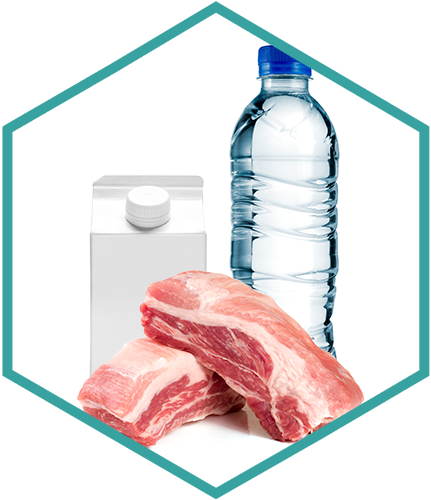Peel Plate Microbial Tests
Food and Water Microbiology Made Easy

Peel Plates use gold-standard method formulation and procedures and are available for targeting a variety of bacterial indicators to supplement most food safety programs. The tests and indicator results can be documented, recorded, and proactively reacted to in your effective food safety and consumer protection programs.
Recent Blogs
Sanitation Verification is the Proactive Foundation to Wholesome Food Production and Food Safety
Sanitation Verification: Food Production and Food Safety Sanitation programs with frequent verification in food plants are the foundation to microbiological or allergen hazard control. Responsible individuals perform visual, olfactory, and adenosine...
An Ounce of Prevention: The Food Safety Act Wants to Catch Outbreaks Before They Start
Food safety inspections are an important part of the industry that grows, produces, and distributes our food. About one in six Americans—around 48 million—get sick every year from foodborne illnesses. Even more alarming nearly 128,000 are hospitalized, and 3,000 people die each year from foodborne diseases according to the Centers for Disease Control and Prevention.
Recent Press Releases
Charm Sciences Inc. Awarded ISO 9001:2015 Recertification
Charm Sciences Inc. Awarded ISO 9001:2015 Recertification Charm Sciences is pleased to announce our ISO 9001:2015 Quality Management System (QMS) three-year recertification for the design and manufacture of microbial detection products for food safety and quality...
Charm Peel Plate Enterobacteriaceae Test Received OMA Final Action
Charm Peel Plate Enterobacteriaceae Test Received OMA Final Action Charm Sciences, Inc. is pleased to report that the Charm Peel Plate EB Microbial Test received AOAC Official Method of Analysis status in fall of 2020. The final action notice was published in November...
Validated food matrices include dairy products, meat, produce rinses, water, and food environmental monitoring. With Peel Plate, you receive the same trusted results without the media prep time and labor. In addition, Peel Plates use an easy to interpret color development to determine bacterial growth, rather than a more subjective gas production of some other methods.
Each single-use microbial test contains prepared media in a shallow dish with an adhesive top cover. To plate a food or water sample, peel up the adhesive to expose the media, pipette into the center of the plate, watch the sample wick and spread into the media. The test gels solidify within 10 seconds (30 seconds for High Volume test). Plates are designed for uniform heat and air flow and with an air space above growth to allow opening and picking of growth for additional microbiological procedures and identification.
Peel Plate certifications and acceptances include Association of Analytical Communities (AOAC), and Pasteurized Milk Ordinance (PMO) and MicroVal on select plates and foods. MicroVal is a European-based validation body that certifies according to International Standards Organization (ISO) reference standards.
The Enterobacteriaceae bacteria are a family of gram-negative bacteria encompassing coliform, E. coli, Shigella, Salmonella, and Yersinia. These bacteria indicate unsanitary conditions in raw products and are killed by heat steps in food processing. EB testing is used as a post-production verification of process and pathogen risk used, for example, to test dry milk powder and infant formula. EB is regulated globally, similar to coliform/E. coli regulations in the US, to verify sanitation processes in food production. Charm’s Peel Plate EB is one of the first microbial tests to be certified under a harmonized MicroVal and AOAC-OMA (Official Methods of Analysis) process. Incubation 24 to 48 hours at 37°C produce multiple colored round growth spots that are all recorded as EB. High Volume plates using 5mL samples are available.
Peel Plate AC Test
Peel Plate AC nutrient rich non-selective media encourages the growth of all aerobic, oxygen consuming bacteria. Aerobic counts are used as tools in identifying sanitation issues, potential shelf life issues, and are considered elevated listeria risk indicator in food production environmental monitoring. Peel Plate AC are AOAC-RI validated and PMO approved for a variety of dairy, food and environmental samples. Aerobes appear as red spots with a defined center within 48 hours at 32 or 35ºC; size may vary.
Peel Plate CC Test
Peel Plate EB Test
The Enterobacteriaceae bacteria are a family of gram negative bacteria encompassing coliform, E. coli, Shigella, Salmonella, and Yersinia. These bacteria indicate unsanitary conditions in raw products and are killed by heat steps in food processing. EB testing is used as a post-production verification of process and pathogen risk used, for example, to test dry milk powder and infant formula. EB is regulated globally, similar to coliform/E.coliregulation in the US. Incubation 24 to 48 hours at 37°C produce multiple colored round growth spots that are all recorded as EB. High Volume plates are available.
To learn more, visit the Peel Plate EB page.
Peel Plate EC Test
Peel Plate HET Test
Peel Plate YM Test
Benefits
-
-
- Ready-to-use media – self-wicking, no spreader device required
- 12 month room temperature stability when stored in re-sealable foil zip bag*
- Buffered media formulation for robust performance with neutralizing buffers – pH adjustments not required for most samples
- Convenient plate stacking and built-in air space design for improved air circulation and picking colonies
- Date tracking and analysis available with use of our Peel Plate Colony Counter
*High Volume tests and certified milk labs require refrigerated storage (0 – 4.5°C)
-
Regulatory Info
- Coliform and Aerobic tests voted by the National Conference on Interstate Milk Shipments (NCIMS) for inclusion into Pasteurized Milk Ordinance (PMO).
